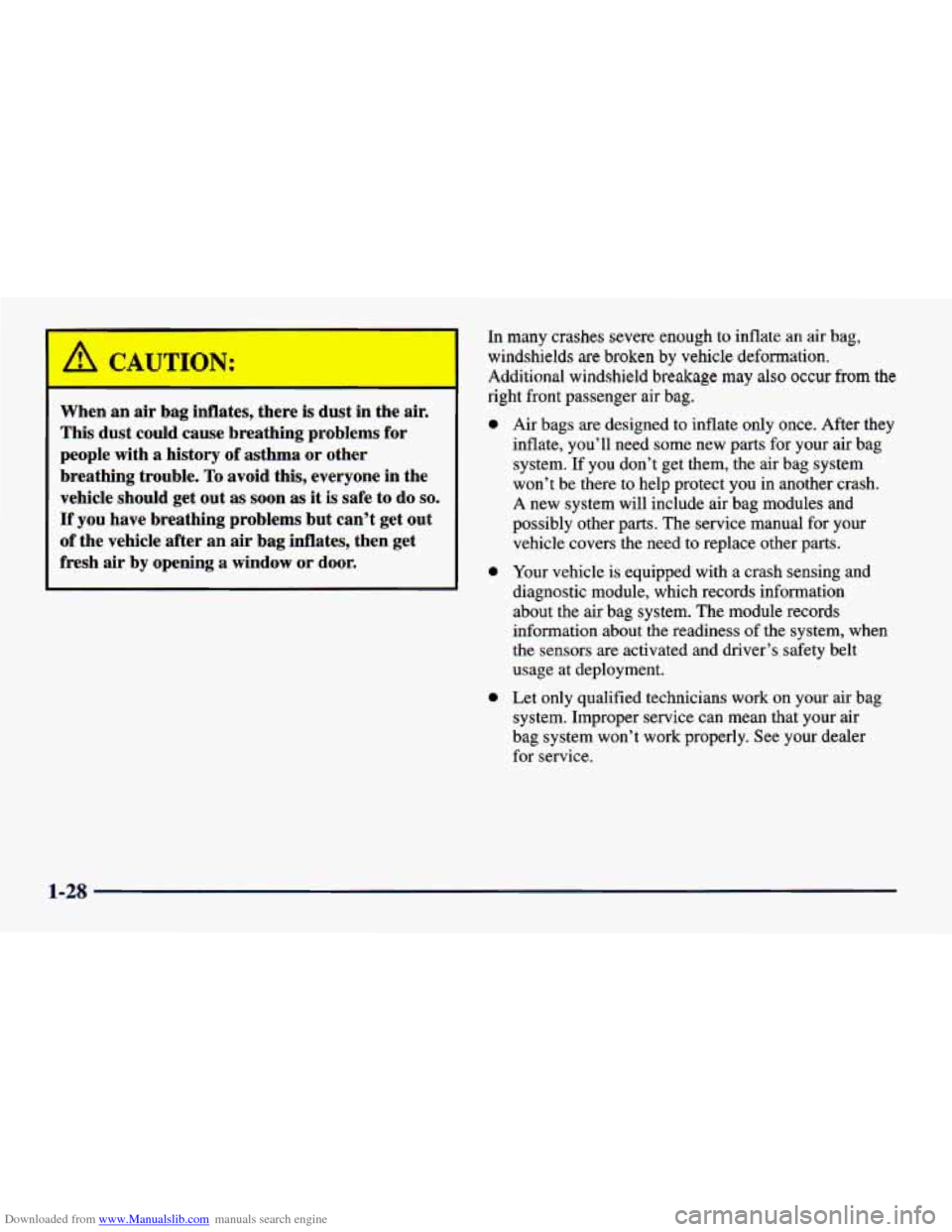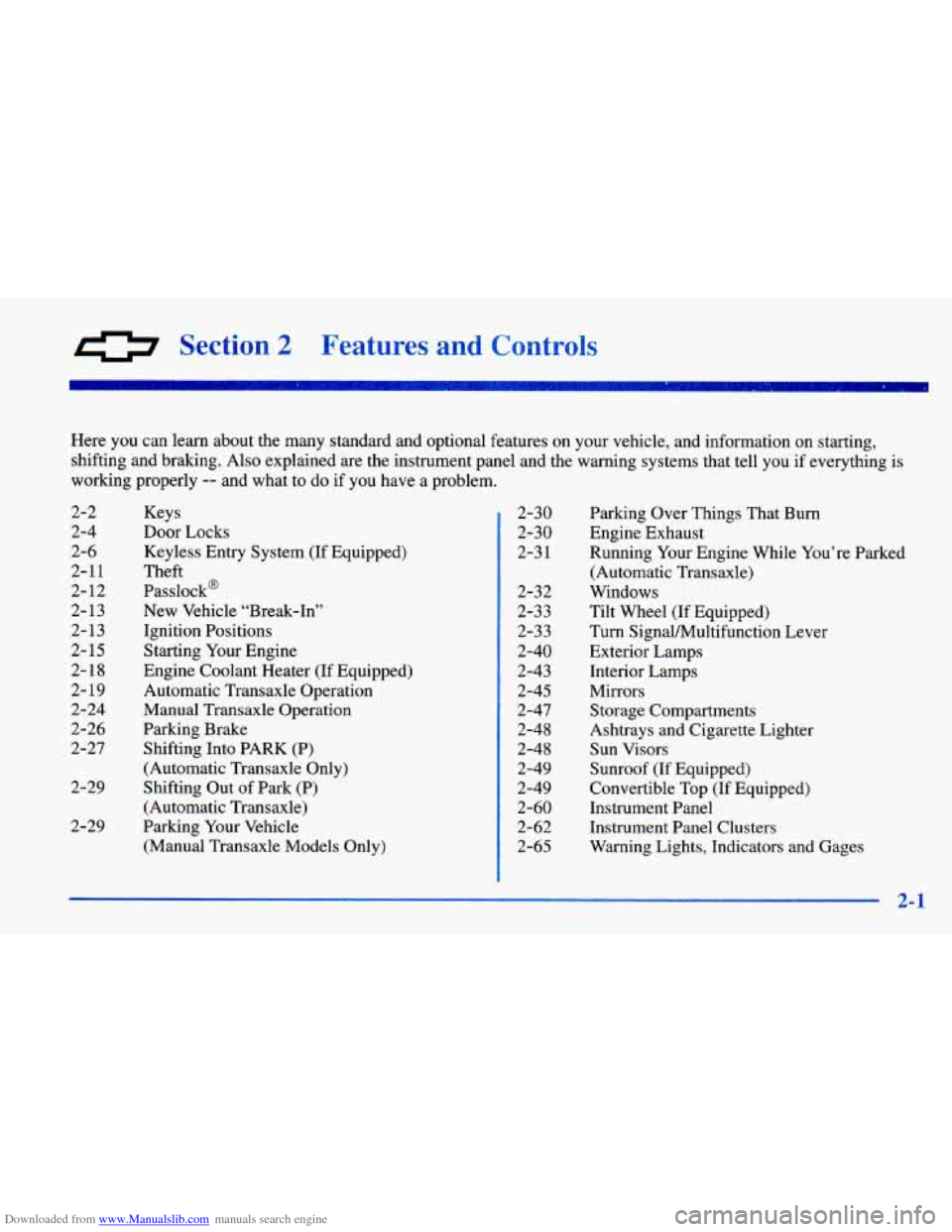Page 8 of 400
Downloaded from www.Manualslib.com manuals search engine Fuse
TRN-BL
F/P-INJ
RR
DFOG
CLUSTER
I TRN-BIL~ ERLS 1 ALA;' PCMIIGN I IGN 1
FIP- INJ AIR BAG CRUISE
RR DFOG PWR ACC STOP HA L HDLP R HDLP
CLUSTER EXT LAMP INT LAMP
HORN
I I I INST LPS I I I
I I I I
I 02 HTR I HVAC I I I I
1
WIPER RADIO
Usage
Exterior Lamps, Back-up Lamps
Fuel Pump, Fuel Injectors
Rear Window Defogger
Instrument Cluster, Anti-Lock
Brake System
Fuse
CLS/PCM
02 HTR
WIPER
ERLS
AIR BAG
PWR ACC
EXT LAMP
HVAC
Usage
Instrument Cluster, Powertrain
Control Module, Daytime
Running Lamps
Rear
02 Sensor Heater
Windshield Wipers,
Windshield Washers
Automatic Transaxle, Brake
Transaxle Shift Interlock, A/C
Compressor, Cruise Control,
Multiport Fuel Injection
Supplemental Inflatable
Restraint System
Power Door Locks, Convertible
Top (Convertible Model Only)
Exterior Lamps, Instrument
Panel Lights
Heater and NC Control, Engine
Cooling
Fan
Page 9 of 400
Downloaded from www.Manualslib.com manuals search engine Fuse
RADIO
ALARM
CRUISE
STOP/HAZ
CIG
INST LPS
PCWIGN
L HDLP
Usage
Radio, Remote Keyless Entry
Alarm Module
- Interior Lamps,
Warning Chimes
Cruise Control
Exterior Lamps, Anti-Lock
Brake System, Cruise Control,
Turn Signals
Cigarette Lighter
Instrument Panel Lights,
Warning Chimes
Powertrain Control Module
Left Headlamp, Fog Lamp
(2-24 Model Only)
Fuse
INT LAMP
IGN
R HDLP
HORN
Usage
Alarm Module: Illuminated Entry,
Warning Chimes, Overhead
Lamps, Map/Reading Lamps,
Glove
Box Lamp, Trunk Lamp,
Radio, Power Mirrors, Remote
Keyless
Entry
Engine Ignition
Right Headlamp, Fog Lamp
(2-24 Model Only)
Horn, Diagnostic Connectm
PWR WDO/SRF Power Windows, Power Sunroof,
Convertible Top Controls
(Convertible Model Only)
(Circuit Breaker)
DRL Daytime Running Lamps (Relay)
3
Page 18 of 400
Downloaded from www.Manualslib.com manuals search engine Vehicle Symbols
These are some of the symbols you may find on your vehicle.
For example,
these symbols are used on an
original battery:
POSSIBLE A
CAUTION
INJURY
PROTECT EYES BY
SHIELDING
CAUSTIC
ACID COULD BAlTERY
CAUSE
BURNS
AVOID
SPARKS OR FLAMES
SPARK
OR ,111,
COULD FLAME
EXPLODE BAITERY
These symbols
are important
for you and
your passengers whenever your
vehicle is
driven:
DOOR LOCK
UNLOCK
n
WINDOW ISJ
These symbols
have to do with
your lamps:
RUNNING 0
DAYTIME -0 0
LAMPS '**
FOG LAMPS $0
These symbols
are on some of
your controls:
WINDSHIELD
DEFROSTER
WINDOW
DEFOGGER
VENTILATING FAN
These symbols
are used on
warning and
indicator lights:
CHARGING BAllERY
SYSTEM
BRAKE
(a)
COOLANT a
ENGINE OIL
PRESSURE
ANTI-LOCK
(a)
BRAKES
Here are some
other symbols
you may see:
FUSE
LIGHTER
n
HORN )tr
SPEAKER
b
FUEL p3
1
viii
Page 46 of 400

Downloaded from www.Manualslib.com manuals search engine When an air bag inflates, thc- J is dust in the air.
This dust could cause breathing problems
for
people with a history of asthma or other
breathing trouble.
To avoid this, everyone in the
vehicle should get out
as soon as it is safe to do sc
If you have breathing problems but can’t get out
of the vehicle after an air bag inflates, then get
fresh air by opening
a window or door.
In many crashes severe enough to inflate an air bag,
windshields are broken by vehicle deformation.
Additional windshield breakage
may also occur from the
right front passenger air bag.
0
0
0
Air bags are designed to inflate only once. After they
inflate, you’ll need some new parts for your air bag
system. If you don’t get them, the air bag system
won’t be there to help protect you in another crash.
A new system will include air bag modules and
possibly other parts. The service manual for your
vehicle covers the need to replace other parts.
Your vehicle is equipped with a crash sensing and
diagnostic module, which records information
about the air bag system. The module records
information about
the readiness of the system, when
the sensors are activated and driver’s safety belt
usage at deployment.
Let only qualified technicians work
on your air bag
system. Improper service can mean that your air
bag system won’t work properly. See your dealer
for service.
1-28
Page 48 of 400
Downloaded from www.Manualslib.com manuals search engine Rear Seat Passengers
It’s very important for rear seat passengers to buckle up!
Accident statistics show that unbelted people in the rear
seat
are hurt more often in crashes than those who are
wearing safety belts.
Rear passengers who aren’t safety belted can be thrown
out of the vehicle in a crash. And they can strike others
in the vehicle who are wearing safety belts.
Rear Seat Outside Passenger Positions
Lap-Shoulder Belt
The positions next to the windows have lap-shoulder
belts. Here’s how to wear one properly.
1. Pick up the latch plate and pull the belt across you.
Don’t let it get twisted.
The shoulder belt may lock if you pull the belt across
you very quickly.
If this happens, let the belt go back
slightly to unlock it. Then pull the belt across you
more slowly.
2. Push the latch plate into the buckle until it clicks.
1-30
Page 61 of 400
Downloaded from www.Manualslib.com manuals search engine A booster seat (F, G) is designed for children who
are about 40 to 60 lbs. (18 to 27 kg) and about
four to eight years
of age. It’s designed to improve
the fit of the vehicle’s safety belt system. Booster
seats with shields use lap-only belts; however,
booster seats without shields use lap-shoulder
belts. Booster seats can also help a child to see
out the window.
1-43
Page 70 of 400
Downloaded from www.Manualslib.com manuals search engine 5. To tighten the belt, pull up on the shoulder belt while
you push down on the child restraint. You may find it
helpful to use your knee to push down on the child
restraint as you tighten the belt.
directions to be sure it is secure.
6. Push and pull the child restraint in different
To remove the child restraint, just unbuckle the vehicle’s
safety belt and let it
go back all the way. The safety belt
will move freely again and be ready to work
for an adult
or larger child passenger.
Larger Children
Children who have outgrown child restraints should
wear the vehicle’s safety belts.
If you have the choice, a child should sit next to a
window
so the child can wear a lap-shoulder belt and
get the additional restraint a shoulder belt can provide.
1-52
Page 77 of 400

Downloaded from www.Manualslib.com manuals search engine 0 Section 2 Features and Controls
Here you can learn about the many standard and optional featur\
es on your vehicle, and information on starting,
shifting and braking. Also explained are the instrument panel and the warning systems that tell you if everything is
working properly
-- and what to do if you have a problem.
2-2
2-4
2-6
2-11
2- 12
2-13
2-
13
2- 15
2-18
2- 19
2-24
2-26
2-27
2-29
2-29
Keys
Door Locks Keyless Entry System (If Equipped)
Theft
Passlock@
New Vehicle “Break-In”
Ignition Positions
Starting Your Engine
Engine Coolant Heater (If Equipped) Automatic Transaxle Operation
Manual Transaxle Operation
Parking Brake
Shifting Into PARK (P)
(Automatic Transaxle Only)
Shifting Out of Park
(P)
(Automatic Transaxle)
Parking Your Vehicle
(Manual Transaxle Models Only)
2-30
2-30
2-3 1
2-32
2-33
2-33
2-40
2-43
2-45
2-47
2-48
2-48
2-49
2-49
2-60
2-62 2-65 Parking Over Things That Burn
Engine Exhaust
Running Your Engine While You’re Parked
(Automatic Transaxle)
Windows
Tilt Wheel (If Equipped)
Turn SignalMultifunction Lever
Exterior Lamps
Interior Lamps
Mirrors Storage Compartments
Ashtrays and Cigarette Lighter Sun Visors
Sunroof
(If Equipped)
Convertible Top (If Equipped) Instrument Panel
Instrument Panel Clusters
Warning Lights, Indicators and Gages
2-1